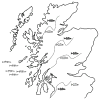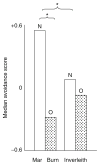Approaching the genomics of risk-taking behavior
- PMID: 20109660
- PMCID: PMC3961474
- DOI: 10.1016/S0065-2660(09)68004-4
Approaching the genomics of risk-taking behavior
Abstract
Individual animals differ in their propensity to engage in dangerous situations, or in their risk-taking behavior. There is a heritable basis to some of this variation, but the environment plays an important role in shaping individuals' risk-taking propensity as well. This chapter describes some of the challenges in studying the genetic basis of individual differences in risk-taking behavior, arguing new insights will emerge from studies which take a whole-genome approach and which simultaneously consider both genetic and environmental influences on the behavior. The availability of genomic tools for three-spined stickleback, a small fish renowned for its variable behavior, opens up new possibilities for studying the genetic basis of natural, adaptive variation in risk-taking behavior. After introducing the general biology of sticklebacks, the chapter summarizes the existing literature on the genetic and environmental influences on risk-taking behavior, and describes the overall strategy that our group is taking to identify inherited and environmentally responsive genes related to risk-taking behavior in this species. Insights gleaned from such studies will be relevant to our understanding of similar behaviors in other organisms, including ourselves.
Copyright 2009 Elsevier Inc. All rights reserved.
Figures








References
-
- Adamec RE, Burton P, et al. Vulnerability to mild predator stress in serotonin transporter knockout mice. Behav Brain Res. 2006;170:126–140. - PubMed
-
- Bakker TCM. Aggressiveness in sticklebacks (Gasterosteus aculeatus) a behavior-genetic study. Behaviour. 1986;98:1–144.
-
- Bakker TCM. Evolution of aggressive behaviour in the threespine stickleback. In: Bell MA, Foster SA, editors. The Evolutionary Biology of the Threespine Stickleback. Oxford University Press; Oxford: 1994. pp. 345–379.
-
- Beaumont C, Roussot O, et al. A genome scan with AFLP((TM)) markers to detect fearfulness-related QTLs in Japanese quail. Anim Genet. 2005;36:401–407. - PubMed
Publication types
MeSH terms
Grants and funding
LinkOut - more resources
Full Text Sources

